The Philippine ghost animal, or tarsier, is a tiny animal with huge eyes that lives in the Philippines. There are two places on the island of Bohol where you can see them, and we visited both.
Table of contents
Philippine ghost animal
The Philippine ghost animal is a species of ghost animal, which is a kind of higher primate, but not a monkey. The animals are tiny and the Philippine ghost animal measures only 117-127 millimetres, not counting the tail. They weigh 110-153 grams, which is about the weight of an apple ...
The most characteristic feature is the gigantic eyes, which are adapted to see in the dark. The eyes cannot move in their sockets, but the ghost animal can turn its entire head 180 degrees.

The animals, which are nocturnal and sleep during the day, feed on a variety of insects and other small animals such as lizards and small birds. They have one baby at a time, which the mother carries in her stomach for six months. Another interesting thing is that it has been discovered that they communicate with each other using ultrasound, at frequencies that humans cannot perceive.
These small creatures are shy and delicate, and the species has 'near threatened' status. Among other things, the animals are easily stressed and, if stressed, they may kill themselves by banging their heads hard against a tree trunk.

Two places on Bohol where you can see the Philippine ghost animal
The Philippine ghost animal lives in several places in the Philippines, mainly on the islands of Bohol, Dinagat, Leyte, Samar, Palawan and Mindanao. If you visit Bohol, there are two places to see them:
- Philippine Tarsier Sanctuary, Corella
- Tarsier Conservation Area, Loboc
Given the near threatened nature of the species and the sensitivity of the animals, it is of course important that they are properly cared for and that efforts are made for their conservation. Whilst we cannot assess all aspects, our feeling is that Philippine Tarsier Sanctuary is the best place from this perspective. The environment was much calmer and quieter, and we got much more information about the animals and their needs.
We took a moped to both places, which are about 40 minutes apart, and tell you about both visits.

1st Philippine Tarsier Sanctuary
We started by visiting Philippine Tarsier Sanctuarywhich is the smaller and less touristy of the two places. Already a bit before we arrived, we were met by a sign asking us to be quiet. The Philippine ghost animals live in the surrounding forests!

When we arrived, we were welcomed, paid an entrance fee (about 30 SEK/person) and given our own guide who took us out on a trail where we would see the Philippine ghost animals. We weren't the only tourists here - two other couples were being guided on the trail at the same time - but everyone made an effort to be as quiet as possible.

In the trees we could look at the Philippine ghost animals. They are really incredibly small, and photographing them from a distance with a mobile phone camera is not the easiest thing to do, so you have to make do with some grainy pictures.
There were only four ghost animals along the trail according to the guide, of which we could see three. Since they are nocturnal, they were sleeping, or peering sleepily at us.



After the short tour, which was done in silence, we went back to the main building, where there is a small exhibition with text, pictures and some interactive elements. The guide followed us around and told us about the animals, and we could also ask questions about anything we wanted. It was a relatively short, but pleasant and educational visit.

2. tarsier conservation area
Our next stop was at Tarsier Conservation Area, which is a much more touristy place. Here we were greeted by a large entrance and many tourists, probably from South Korea, but also from Europe.

We paid the entrance fee (about 25 SEK/person), walked past a souvenir shop, took a photo of ourselves at an "I love Bohol" sign, and went out on the path where we would see ghost animals. Here you walked on your own, without a guide, but you quickly saw where the ghost animals sat because large clusters gathered there.
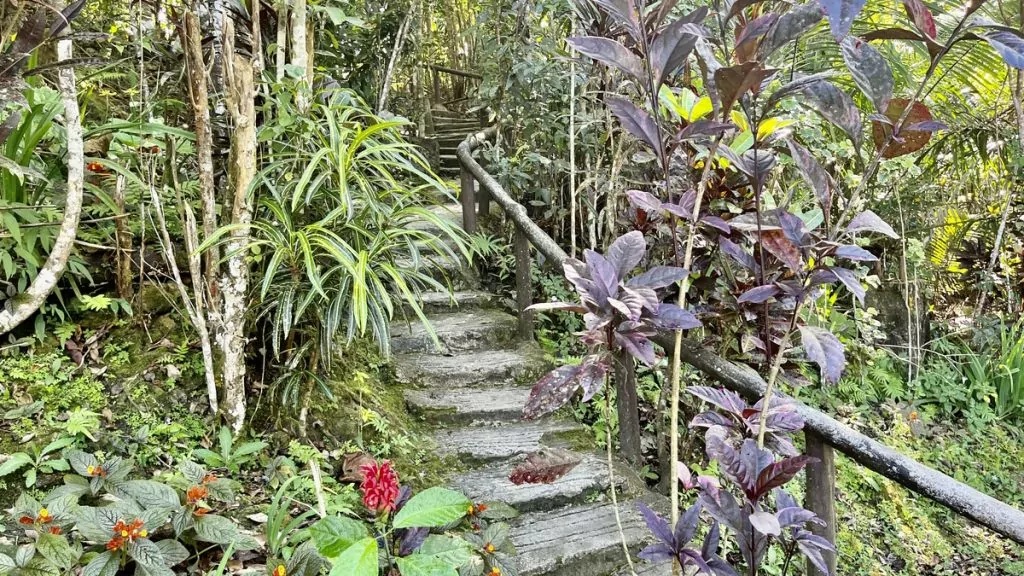


Again, there were signs telling you to be quiet, but this was not respected in the same way. One Asian tourist made a lot of noise to get a poor animal to look up, which didn't feel good considering they normally sleep during the day.
You could also queue to take a selfie in front of a ghost animal, but we didn't do that. We didn't learn much about the animals here, but the walkway was much longer and there were more ghost animals to see.

Cars Man-Made Forest
Right next to the Tarsier Conservation Area is the Bilar Man-Made Forest, which is also worth checking out. This is a dense forest that extends two kilometres in the vicinity of the towns of Loboc and Bilar. The forest consists mainly of white and red mahogany trees, and is part of a reforestation project that started over 50 years ago.

Bilar Eco Park
We made an unscheduled stop at the Bilar Eco Park, which is also located here.
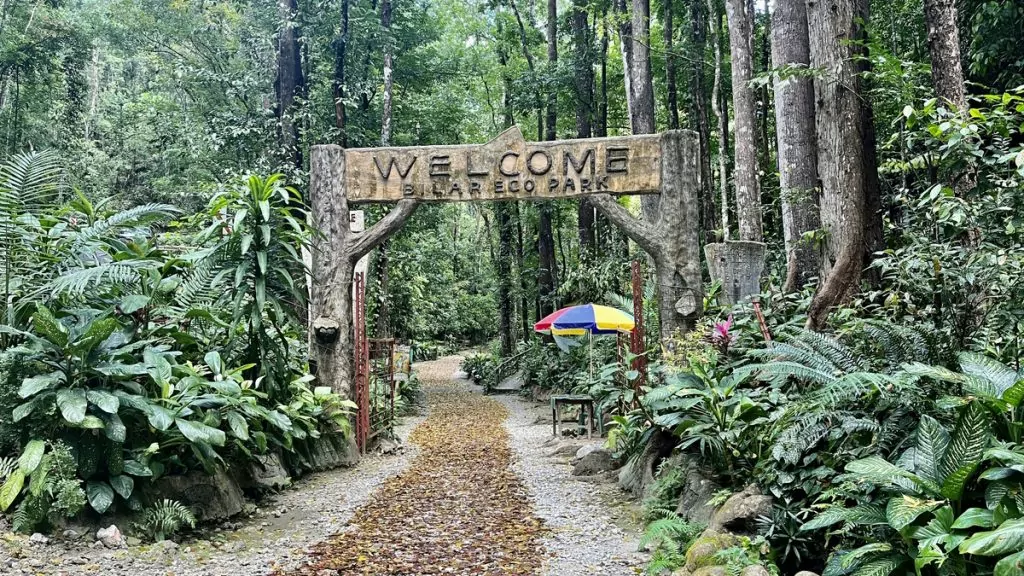
For a tiny entrance fee (about two kronor) we walked around in the beautiful forest. According to the woman who charged us, there would be a small cave further away, but we were getting tired, and since we had quite a long hike ahead of us, we didn't stay long.



More to see and do in the neighbourhood
In the neighbourhood of these places to see the Philippine ghost animal, you can see the much talked about The chocolate hills. You can also visit the theme park Sikatuna's Mirror of the World or take a boat trip on the River Loboc. It's also not too far to the touristy island. Panglao, where you will find several nice beaches. Find all our tips for Bohol here.
Boracay in the Philippines - tourist paradise
Boracay in the Philippines is an island paradise with a long, beautiful sandy beach and plenty of hotels, restaurants and...
Bogo on Cebu Island in the Philippines - a shopping trip
Bogo is a city located on the island of Cebu in the Philippines. This is the nearest major...
Digyo Island in the Philippines - in the Cuatro Islas archipelago
The island of Digyo is one of four Philippine islands collectively known as "Cuatro Islas" (Four Islands)....
What do you eat in the Philippines? - 15 Filipino specialities
What to eat in the Philippines? We spent three months on 30 different islands in the Philippines....
Guest of the Week: Katarina Söderberg, passionate about school projects in the Philippines
Katarina Söderberg currently lives in Norrland, but has spent many years on the island of Bohol in the Philippines....
Manila in the Philippines - exciting city despite bad reputation
Manila in the Philippines is a capital city where many people land by plane, only to travel on...
Tulang Diot in the Philippines - a cosy little island
Tulang Diot is a cosy little island in the Philippines, located in the municipality of...
Philippine ghost animal - 2 places to see them on Bohol Island
The Philippine ghost animal, or tarsier as they are called in English, is a tiny animal with enormous...
Bounty Beach in Malapascua - lovely beach in the Philippines
Bounty Beach is a beautiful beach on the island of Malapascua in the Philippines, and also the most...
Departure with Dotche - now the boat trip in the Philippines begins
It's finally time for the departure of the boat Dotche, which means that we start our...
Snorkelling at Malapascua in the Philippines - a wonderful trip
Now that we've tried snorkelling on Malapascua in the Philippines, we understand why this island...
Fishing in the Philippines - with a Filipino family
Now we have tried fishing in the Philippines, together with the Filipino family we got to know....
Preparing for a boat trip - an adventure in the Philippines
We are currently preparing, as some of you know, for a boat trip among the islands of...
Islands in the Philippines - these 30 we've visited
There are many, many islands in the Philippines. The whole country is made up of larger and smaller islands and...
From Cebu City to Malapascua Island in the Philippines
Although it was interesting to experience Cebu City, it is the quieter life...
Tabango on Leyte Island - island hopping in the Philippines
Tabango is a small town in the Philippines located on the island of Leyte. This was our first...
Things to do in Boracay, Philippines - 15 tips
What to see and do in Boracay, Philippines? Boracay is a small Philippine island,...
Pacijan Island in the Philippines - beautiful Camotes Islands
Pacijan Island is a beautiful island in the Camotes Islands in the Philippines. Here you will find among...
Restaurants in Malapascua in the Philippines - 7 tips
Restaurants in Malapascua are what we can tell you about today. We have eaten at some of the finer places...
Things to do in Malapascua, Philippines - 12 tips
What to see and do in Malapascua, Philippines? Malapascua is a small and stunning...
Things to do in Bohol in the Philippines - 15 tips
What to see and do in Bohol, Philippines? Bohol is both an island and...
Boat trip to Manila in the Philippines - from Boracay
Today it was a boat trip to Manila from Boracay. We started with a small boat from Boracay...
Himokilan Island in the Philippines - cave and encounters with the locals
The island of Himokilan, or Himoquitan as it is sometimes spelled, is one of four Philippine islands that together...
Marina Point Bay Resort in Panglao, Philippines
Marina Point Bay Resort, on the island of Panglao in the Philippines, is a really nice place that offers...
Atremaru Jungle Retreat - eco-resort on Palawan in the Philippines
Atremaru Jungle Retreat is an eco-resort on Palawan Island in the Philippines. Here you live in the centre of...
Kalanggaman in the Philippines - an island paradise
Kalanggaman is an island paradise in the Philippines, with white sandy beaches, crystal clear waters and swaying palm trees. This is...
Things to do in Panglao, Philippines - 11 tips
What to see and do in Panglao, Philippines? Panglao is a popular Philippine holiday island, which...
Our trip to the Philippines - from Stockholm to Cebu
Let's tell you about the start of our trip to the Philippines! We have left...
Sikatuna's Mirror of the World in Bohol, Philippines
Sikatuna's Mirror of the World and Botanical Garden is a theme park located on the island of Bohol,...
River cruise on the Loboc River in Bohol, Philippines
River cruise on the Loboc River! This is one of the activities you can enjoy on the...

Have you seen a Philippine ghost animal?
Have you ever seen a Filipino ghost animal, or perhaps some other type of ghost animal? If so, where? Please tell us!
Frequently asked questions about the Philippine ghost animal
Are ghost animals only in the Philippines?
Ghost animals are found in the Philippines, Indonesia, Malaysia and Brunei. The Philippine ghost animal (Tarsius syrichta) is only found in the Philippines.
Is a ghost animal a monkey?
The ghost animal is not a monkey. Ghost animals (Tarsius), like monkeys, belong to the group of higher primates.
What are ghost animals called in English?
Ghost animals are called tarsier in English. Filipino ghost animal named Philippine tarsier.
Facts about the Philippine ghost animal
- Name: Tarsius syrichta in Latin, stomach stomach in the local language Cebuano
- Systematisation: Primates (higher primates), genus: ghost animals
- Conservation status: Near threatened
- Distribution: Mainly on the islands of Bohol, Dinagat, Leyte, Samar, Palawan and Mindanao in the Philippines.
- Size: 117-127 mm long without tail
- Weight: 110-153 grams
- Appearance: Grey-brown fur, almost hairless tail, very large eyes, a head that can be turned 180 degrees.
How the Philippine ghost animal lives
- Activity: At night, between dusk and dawn.
- Communication: With ultrasound
- Food: Insects and other small animals, such as lizards and small birds
- Reproduction: One pup at a time, usually born between April and July. The female is pregnant for about 6 months.
- Lifespan: 2-12 years
- Suicide: Philippine ghost animals can kill themselves if stressed, by banging their delicate head against a tree trunk.
- Hot: Cats, humans and the destruction of their habitats.
Philippine Tarsier Sanctuary
- Address: Tarsier Sunctuary Rd, Corella, Bohol
- Price: 150 pesos/person (about 30 crowns) 2023
- Read more: The Philippine Tarsier Foundation
Tarsier Conservation Area
- Address: Loay Interior Road, Loboc, Bohol
- Price: 120 pesos/person (about 25 crowns) 2023














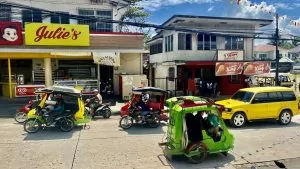



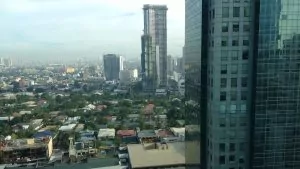
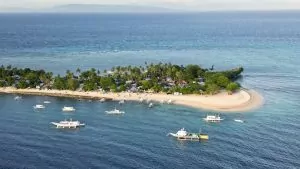
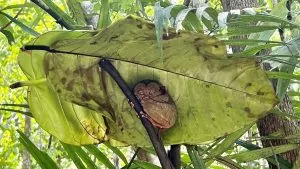



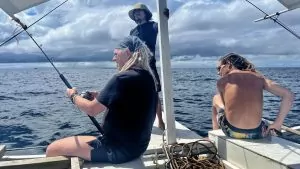









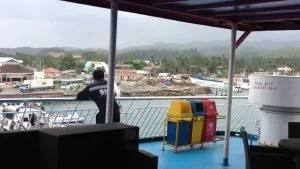









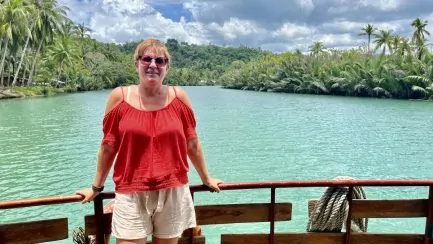







Lena - good for the soul says:
Fascinating little creature! Sad when people can't respect how to behave! I understand that it was a great contrast since you visited the places one after the other.
Hug Lena
04 April 2023 - 9:51
Helena says:
Very special little files! 🙂 And yes, different places, for sure.
05 April 2023 - 2:53
bmlarstravellingblog says:
We've never heard of these ghost animals, but with their big eyes and nocturnal life, they remind us a bit of the galagos (or bushbabies as they were also called) we saw late one night at a camp in South Africa. They were also primates and could be from 7 cm to up to 30-40 cm + a long tail. What we saw in the dark were the big round eyes.
04 April 2023 - 13:39
Helena says:
How interesting!!! I have heard the word bushbabies before, but didn't know what it was. Have googled them now, and agree that there is some similarity!
05 April 2023 - 2:54
BP says:
What a curious creature. It certainly looks like an owl. An ugly-cute creature. Then again, it is rather naive to think that a large group of tourists will keep quiet, I hope the species survives.
04 April 2023 - 20:14
Anna Nilsson Spets says:
Yes, I have seen them too, not this specific species. They are so cooool But ugh, I shudder when I read about people who can't behave and that thing about letting themselves be photographed with the animal... nope.
05 April 2023 - 6:24